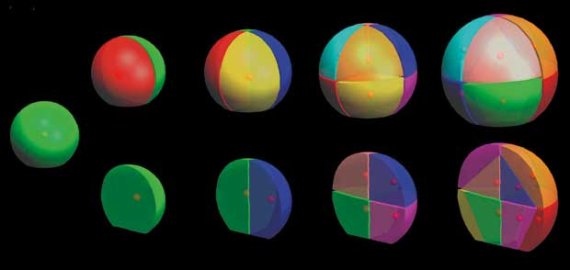Illustration: The three-dimensional model in action. The second and third models show cell division with the smallest possible dividing cell wall. The other cell divisions do not keep to this basic rule.
Interestingly, cells turn out to break this rule. When they are exposed to the plant hormone auxin, they divide unevenly, creating a small and a large daughter cell, which sometimes also divide in another direction. These daughters are very different and while one ends up as epidermis, the other might become part of the vascular system. It is precisely this uneven division that enables plants to change their form. Regular division only enables a plant to grow. ‘An elegant solution,’ says Dolf Weijers, professor of Biochemistry. ‘There is a standard programme and extra input leads to new structures.’
Clear
Plant researchers have been looking for the system behind plant division for more than a hundred years, but up to now they have always used two-dimensional images. For the first time now, the Wageningen team has shown how it really works in three dimensions. To Weijers, the discovery that auxin is the signal is particularly exciting. ‘Ten years ago we saw strange things happen in the course of the development of plants that were not sensitive to auxin,’ he says. ‘At the time we didn’t understand it at all, but it has suddenly become clear now.’
In their experiments, Weijers and his team looked at the divisions of a single-cell plant embryo, using Arabidopsis, a popular model plant. To study their subject, they painted the hard cell walls with a substance that lights up when laser light is shone on it. Using a specialized microscope you can then take photos in the cell. By looking deeper and deeper, Weijers and his team were able to photograph the dividing cell ‘slice by slice.’ Then a computer programme made 3D models of the images, on which you can see exactly where the division is made.
The researchers have no idea, though, how auxin forces the cell to deviate from the norm for division. Weijers is especially interested in how the plant hormone steers cells specifically, alongside all its other functions. Weijers would also like to find out to what extent the situation in the embryo reflects that in the rest of Arabidopsis and other plants. ‘It is not likely to be very different there,’ he says. ‘I think you will see the same situation in a new leaf, flower or lateral root.’

